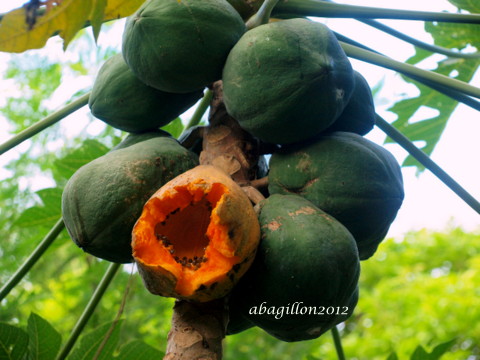I have been telling everyone about our dry season getting hotter and more stressful every year! Two years ago many of our fruits trees died, of course that is over and above the plants smaller and less tough than the trees. This year it was again tough, but unusual typhoon visits during the dry season brought at least one rainy day each in the months of March and May. Thanks to the La Nina phenomenon from the Pacific Ocean, our parched lands and thirsty plants got a slight drink. These unusual rains pacified the trees, but brought very high humidity to animals, which to me feels like being in the oven at 8:00 in the morning. So those of us who are working in big buildings do not venture outdoors unless it is already dark or early evening.
Even if we were officially declared to have started the rainy season in June first, our property in the province seems like it is still in the dry season. However, a lot of plants and bulbs already broke dormancy from the mentioned unusual rains, which gave the picture of a rainy season garden but without the rain! So these plants and flowers describe our unconventional weather and climate this year.
The red-orange amaryllis,
Hipeastrum puniceum, blooms but not simulteneously, and not as lush than when there are more rains during our normal rainy season.
The blood lily,
Haemanthus or Scadoxus multiflorus, also joined the bandwagon but also not as beautiful as when there is plenty of water.
This used cast iron kettle discard has been planted with these bulbs for already three years. The last two years gave simultaneous blooms, but not this time. You can see there are still bulbs just starting to sprout, but apparently not producing flowers.
At least those planted in the ground bloomed at the same time like the above. I am glad that the weeds died out after emergence. That is the beauty of less rain and too much sunlight, weeds will be lessened. Last year the above red blooms have very dark background of green weeds.
Our 'kasupanggil' or red
Clerodendrum intermedium, braved the heat. It is bushy and maybe have deeper roots to support it. Just a slight 1-day rain was able to sustain the flowers to emerge and even produce fruits.
The fruits above are still at the green stage, while those below already turned blue, ripe and ready for the next planting. This flower is loved so much by butterflies and bees, so very well pollinated.
Another bulb, whose dormancy is broken by the slight rains during the dry season is our 'katunggal',
Proiphys amboinensis. It flowered for the first time last year producing only two umbels. I remember posting this last year asking for its elusive identity. Now it has 4 umbels, 2 already spent with seeds and two still in bloom.
Above and below show the developing fruits. I wonder if they will push through, as i remember reading in Jacqui's post that it matures slowly for many months. I hope they can still tolerate the dryness and wait for the real rains. I love this plants, can you see its resemblance to the temperate zone hostas.
The next photos will tell you about its struggle during the hot and dry months. Because their roots are deeper, they were not able to partake with the slight rains. The flowers are short and very much less than when able to get enough rain water.
Caesalpinia pulcherrima, trying hard to produce flowers. I already cut back its stems to be ready for good growths when the rains come.
Duranta erecta/ repens, still producing flowers, but also not as prolific as during the rainy season. This is also very much loved by the insects and butterflies, most especially because there are not much flowers around for them to choose from.
Many twigs already produced fruits, the above are the mature ones. I am delaying its cut-back for the butterflies to still have their nectar in this time of lack. When there are more flowers already, i will cut the branches too.
Above is
Salvia splendens, which look so unpresentable this time. It still struggles to flower during the dry season. Even during the rainy season it doesn't give the lushness and flowering shown when it is planted in colder climates.












































![[Copy_of_001%255B2%255D.png]](http://lh6.ggpht.com/-Dn0zP7GJym4/T9o_smK5C9I/AAAAAAAAWUw/NZ5CEN9Puog/s200/Copy_of_001%25255B2%25255D.png)








.jpg)



